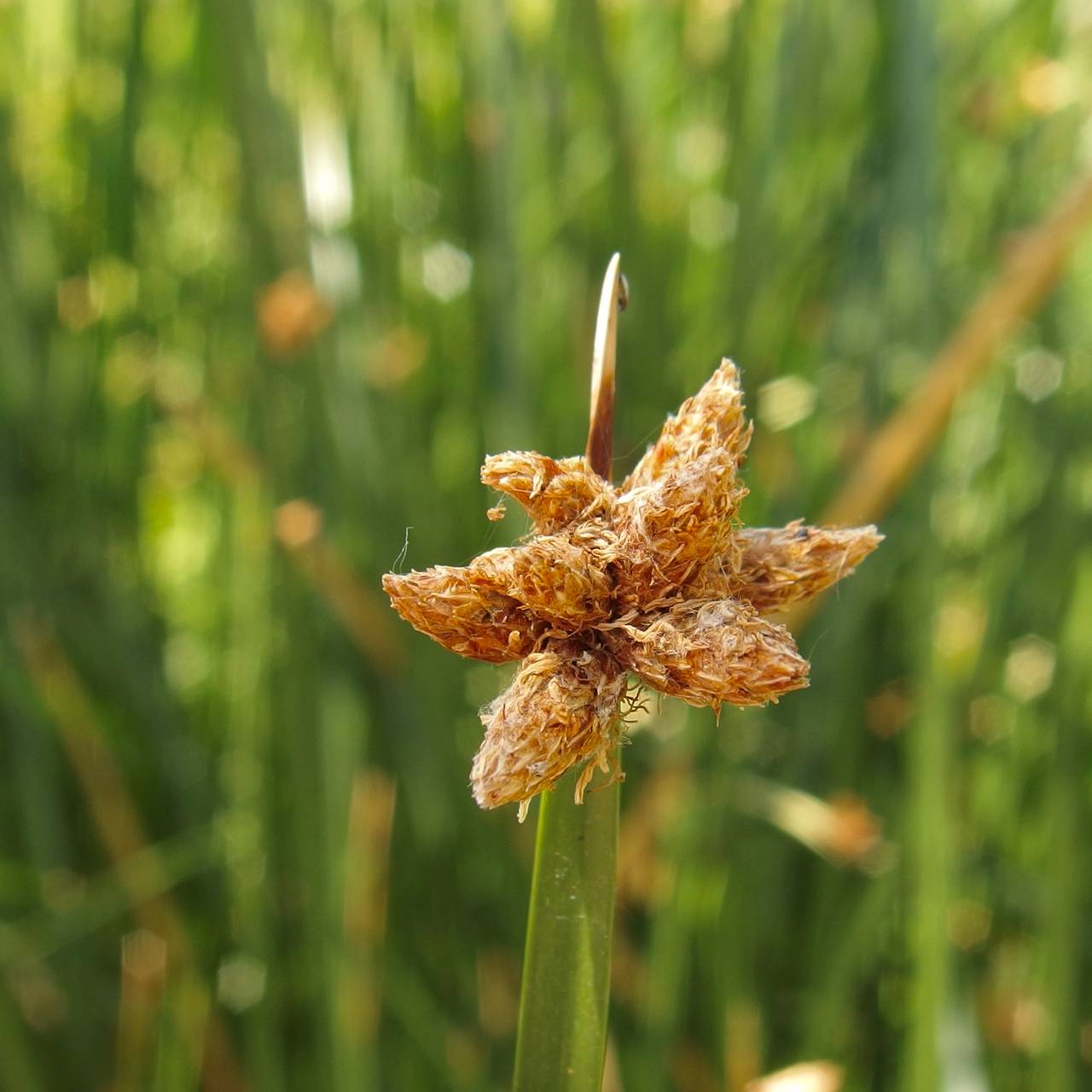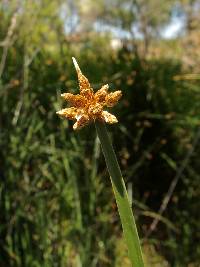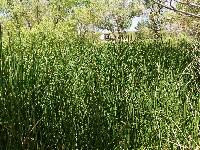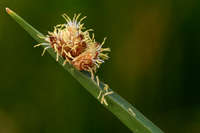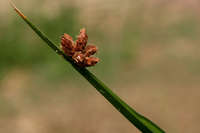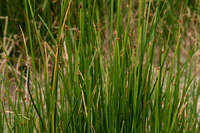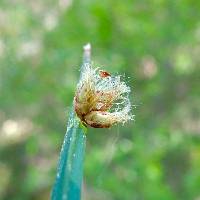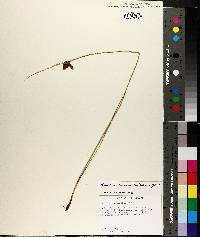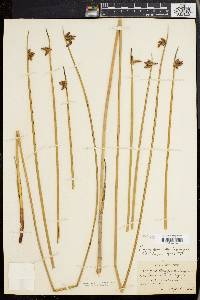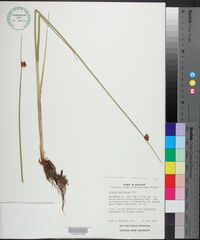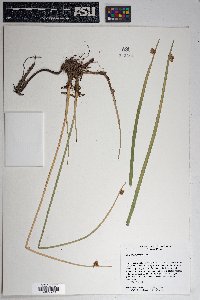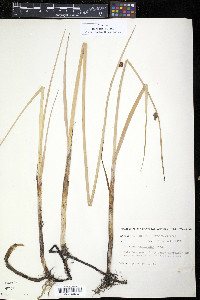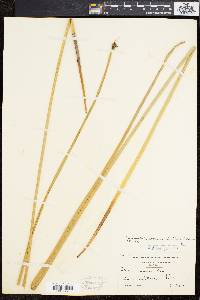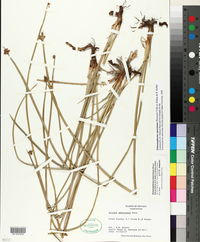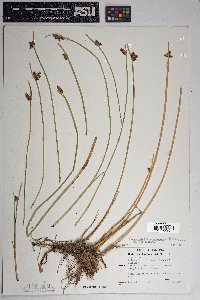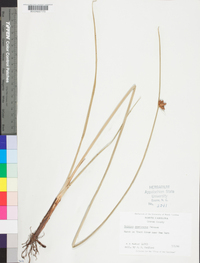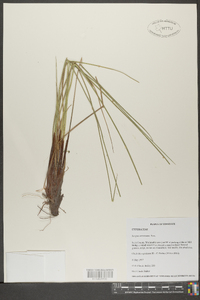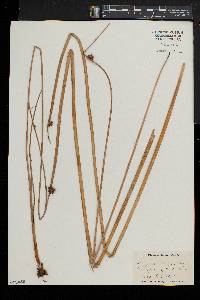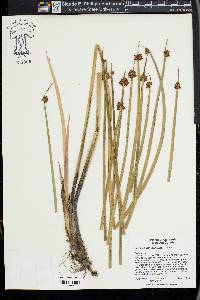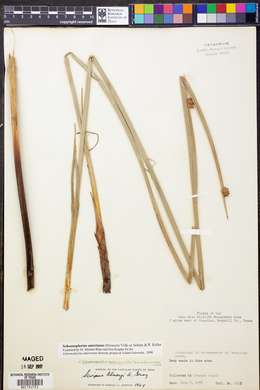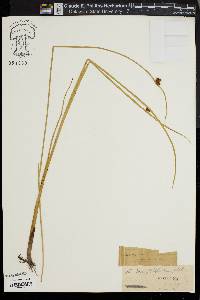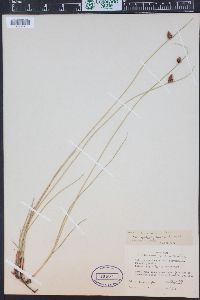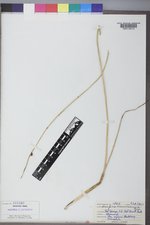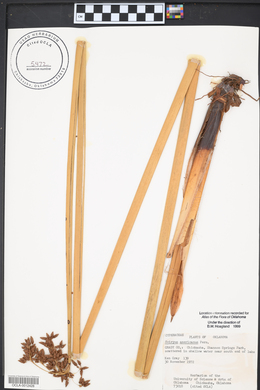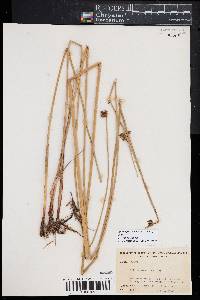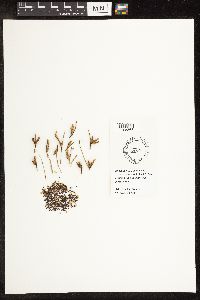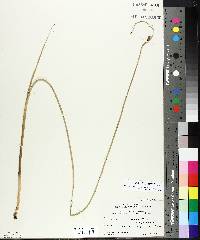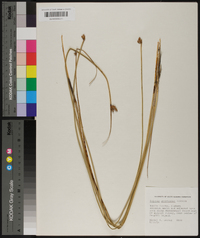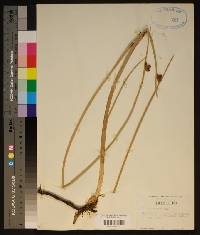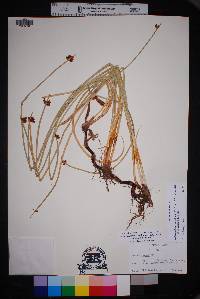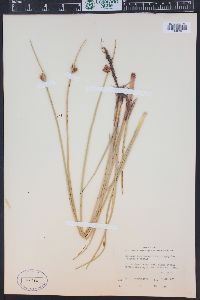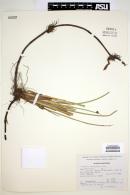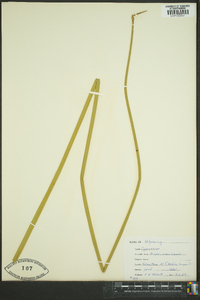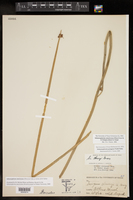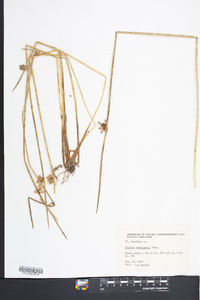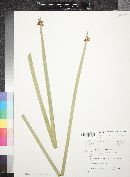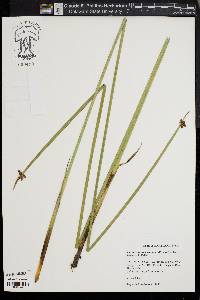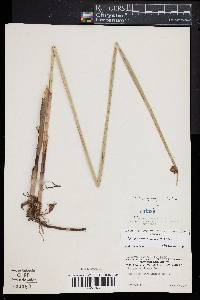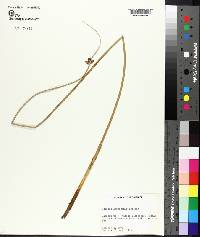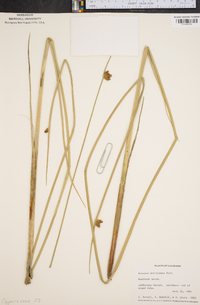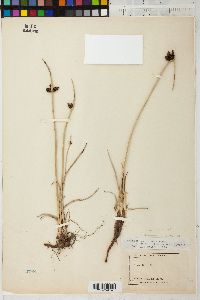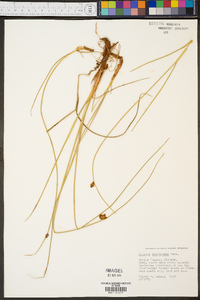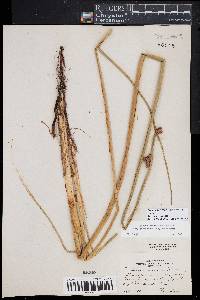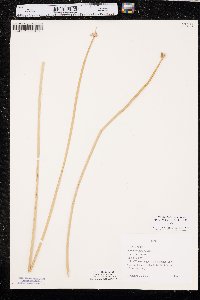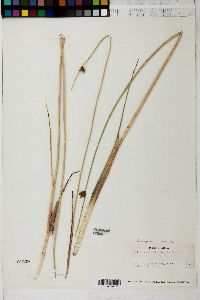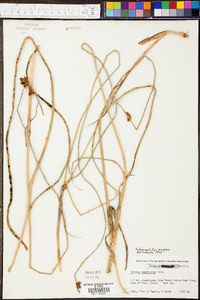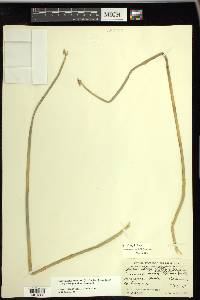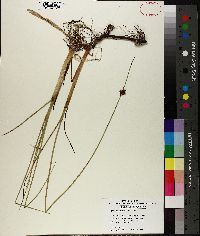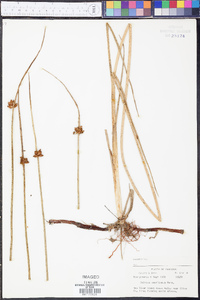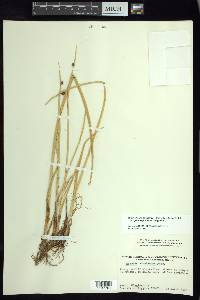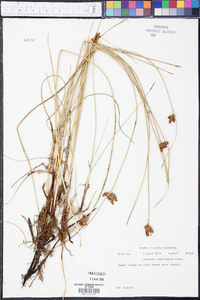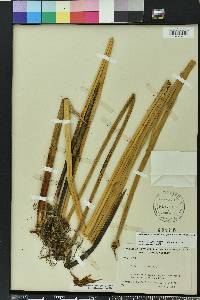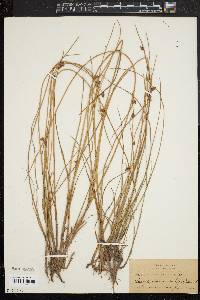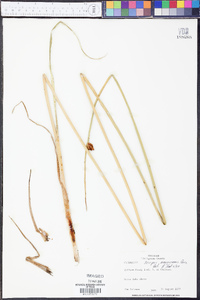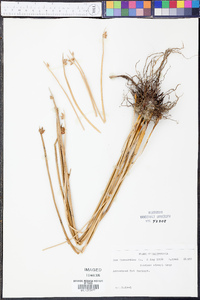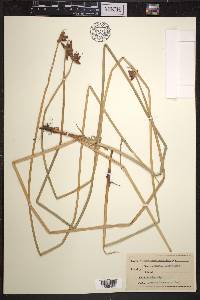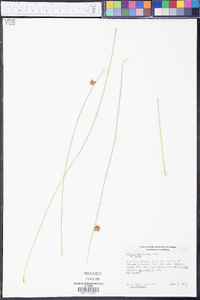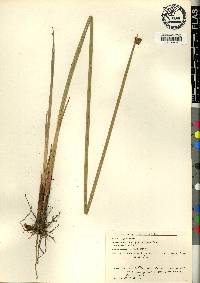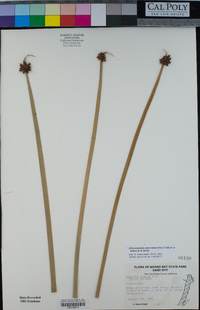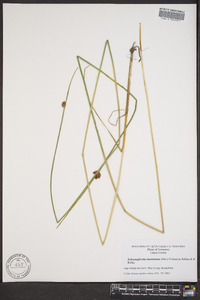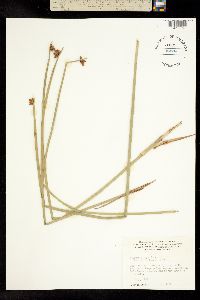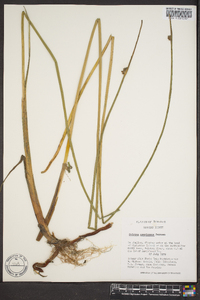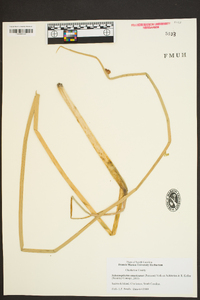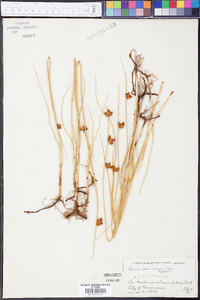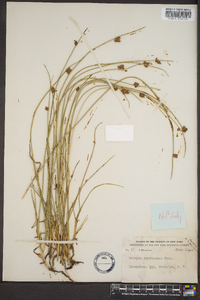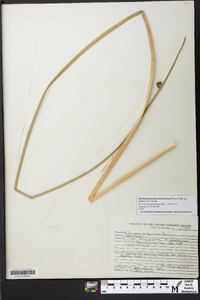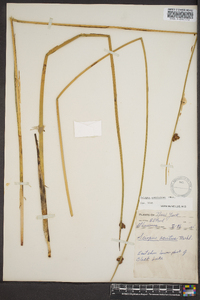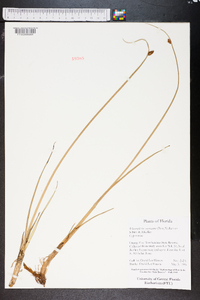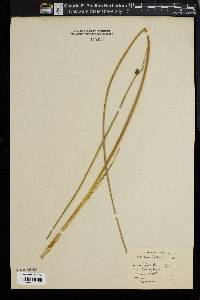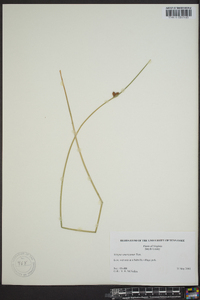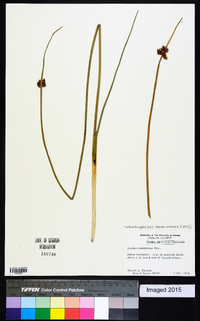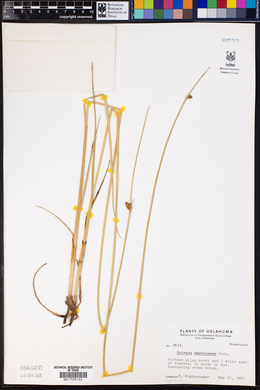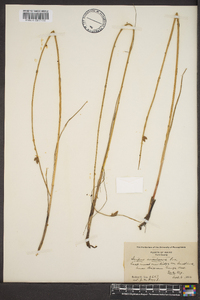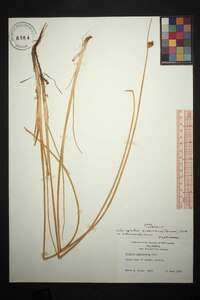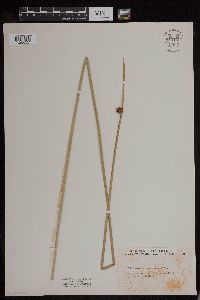
|
Schoenoplectus americanus (Pers.) Volk. ex Schinz & R. Keller
 (redirected from: Scirpus americanus Pers.) (redirected from: Scirpus americanus Pers.) |
|
|
Family: Cyperaceae
chairmaker's bulrush, more...three-square bulrush, American bulrush, Chairmaker's Wood Club-Rush, Olney bulrush, Schoenoplectus (es: tule esquinado)
[Schoenoplectus chilensis (Nees & Meyen) Soják, moreScirpus americanus Pers., Scirpus americanus var. americanus , Scirpus chilensis Nees & Meyen ex Kunth, Scirpus conglomeratus Kunth, Scirpus olneyi A. Gray, Scirpus olneyi var. longisetis Kük., Scirpus pungens var. longisetus Benth. & F. Muell.] |
Rhizomes 2-5 mm diam. Culms sharply trigonous, sides deeply concave throughout to rarely nearly flat, 0.4-2.5 m × 3-10 mm. Leaves ca. 3, basal, less than 1/2 culm length; sheath fronts not pinnate-fibrillose; blades 1-3, V-shaped near base, otherwise laterally flattened-trigonous in cross section; distal blade 0.2-1.5 times as long as sheath, 25-200 × 2-8 mm. Inflorescences capitate or very rarely with 1 branch to 5 mm; proximal bract usually erect, resembling leaf blade, 1-6 cm. Spikelets 2-20, 5-15 × 3-5 mm; scales bright orange- to red- or purple-brown to straw-colored, often partly translucent, usually clearly lineolate-spotted, broadly ovate, 2.7-4 × 2-3 mm, smooth or awn sparsely spinulose, margins deciduously ciliolate, flanks of proximal scale often with several ribs, apex rounded to acute, notch 0.1-0.4 mm deep, awn not contorted, 0.2-0.6 mm. Flowers: perianth members (2-)5-6(-7), yellow-brown, bristlelike, slender to stout, often unequal to equaling 1/2 achene body, retrorsely spinulose; anthers 1.5-3 mm; styles 2-fid or 2-fid and 3-fid. Achenes brown when ripe, thickly plano-convex or unequally biconvex or compressed obtusely trigonous, obovoid, 1.8-2.8 × 1.3-2 mm; beak 0.1-0.3 mm. 2n = 78. Fruiting spring-summer (south), summer (north). Brackish or mineral-rich shores, marshes, fens; 0-2200 m; B.C., N.S.; Ala., Ariz., Calif., Conn., Del., Fla., Ga., Idaho, Kans., La., Maine, Md., Mass., Mich., Miss., Mo., Nev., N.H., N.J., N.Mex., N.Y., N.C., Okla., Oreg., R.I., S.C., Tex., Utah, Vt., Va., Wash., Wyo.; Mexico; West Indies (Puerto Rico); Central America; South America. The secondary involucral bracts of Schoenoplectus americanus lack blades and closely resemble floral scales, in contrast to S. pungens and S. deltarum. Although mostly very locally distributed, S. americanus is ecologically important in many coastal marshes. In recent years it has seriously declined (e.g., in Maryland and Louisiana). It may occur in southwestern Kansas; I have not seen a specimen. It probably has been extirpated from the Missouri station, based on one collection from 1886 (G. Yatskievych, pers. comm.). The report from New Hampshire is based on M. L. Fernald (1950). The stations on the Maine and Connecticut coasts, at Lake Champlain in Vermont, and in Oklahoma are based on putative S. americanus × S. pungens specimens. Some plants in the southwest are atypical in having nearly flat culm sides and leaf blades to 1.5 times as long as their sheaths as in the type of Scirpus monophyllus J. Presl & C. Presl from Peru. The name Scirpes americanus was long misapplied to Schoenoplectus pungens; Schoenoplectus americanus was known as Scirpus olneyi (A. E. Schuyler 1974).
Cronquist et al. 1977, Martin and Hutchins 1980, Kearney and Peebles 1969, Heil et al 2013, FNA 2003, Allred and Ivey 2012, Rink and Licher in prep (draft for NM Flora) Duration: Perennial Nativity: Native Lifeform: Graminoid General: Perennial rush-like herb, 50-150 cm tall, from robust rhizomes; stems loosely clustered or scattered, stout, 5-10 mm thick at the base, sharply triangular, the angles ridged or winged and the sides conspicuously concave. Vegetative: Leaves commonly 1-4 per stem, borne on the lower 1/3 of the stem; lower leaves reduced to blade-less sheaths wrapped around the stem; upper leaves with blades usually less than 10 cm long, strongly folded, 6 mm wide when dried, gradually tapered to a poin Inflorescence: Inflorescence a dense cluster of 2-5 sessile spikelets near the top of the stem, emerging at the base of a green bract that points straight up and appears to be a continuation of the stem; bract 1-5 cm long, with a pointed tip. Spikelets 6-15 mm long, each spikelet consisting of many small spirally arranged flowers, each subtended by a scale; scales yellowish-brown, red-brown, or purplish-brown, and hyaline (papery-textured), with a small notch at the tip and a firm midrib that extends into the notch as a short straight awn. Each scale (flower) produces a single seed; seeds plano-convex, 2-3 mm long. Ecology: Found in wet soils, especially in marshes and meadows from 3,500-8,000 ft (1067-2438 m); flowers June-September. Distribution: Most of the US except the midwest; south through MEX to S. Amer.; also in Europe. Notes: This species is quite similar to Schoenoplectus pungens, and for a time the two species were lumped under the name S. americanus. However, they are currently accepted to be separate taxa. S. americanus is a larger, more robust plant with a more southerly distribution, although the two species can certainly grow side by side. S. americanus has sharply three-sided stems with ridged or winged angles and concave sides, while S. pungens has 3-sided stems that are less sharply triangular, the sides are not concave, and the angles are never winged. Also, use your hand lens to look closely at the flower spikes: each individual flower is subtended by a brown scale. On S. americanus, the scales are shallowly notched at the tip, with a short awn emerging from the notch (notch less than 0.5 mm deep and awn less than 0.6 mm long). On S. pungens, the notches are deeper and the awn emerging from the notch is longer (notch greater than 0.5 mm deep and awn greater than 0.5 mm long.) Ethnobotany: Used as a hair tonic; the roots and shoots were eaten and used for basketry, hats, and other kinds of weaving. Etymology: Schoenoplectus coms from Greek schoinos for rush, reed or cord, and plektos, for twisted or plaited; americanus means of or from America. Synonyms: Scirpus americanus, Scirpus olneyi Editor: SBuckley 2010, FSCoburn 2015, AHazelton 2017 Rhizomatous, colonial perennial 5-20 dm; stems avg stouter than in no. 6 [Scirpus pungens Vahl], often 1+ cm thick below, sharply triquetrous, with conspicuously concave sides, easily flattened in pressing; lvs few, all on the lower part of the stem, with normal sheath and short blade seldom over 1 dm long, sometimes 1 cm wide; spikelets 2-15, essentially sessile in a compact cluster, mostly 6-15 mm, subtended by a prominent, rather blunt, green bract 1-3.5(-5.5) cm that appears like a continuation of the culm, without additional bracts; scales thin, largely hyaline-scarious, the brown midrib firmer and commonly exserted as a short mucro about equaling the distal notch; bristles 4(-6), often unequal, retrorsely barbellate, not much if at all surpassing the achene; style bifid; achene planoconvex, 1.8-2.5 mm (including the 0.3 mm apiculus); 2n=78. Marshes, wet meadows, and other wet, low places, tolerant of alkali; N.S. to Wash., s. to S. Amer. Fr June-Sept. (S. olneyi; Schoenoplectus a.) The sterile hybrid with no. 6 is S. أontortus (A. J. Eames) T. Koyama. Gleason, Henry A. & Cronquist, Arthur J. 1991. Manual of vascular plants of northeastern United States and adjacent Canada. lxxv + 910 pp. ©The New York Botanical Garden. All rights reserved. Used by permission. |
|
|
|
This project was made possible in part by the Institute of Museum and Library Services [MG-70-19-0057-19].
Powered by Symbiota
